
Home - Search - Browse - Alphabetic Index: 0- 1- 2- 3- 4- 5- 6- 7- 8- 9
A- B- C- D- E- F- G- H- I- J- K- L- M- N- O- P- Q- R- S- T- U- V- W- X- Y- Z
Project Deimos
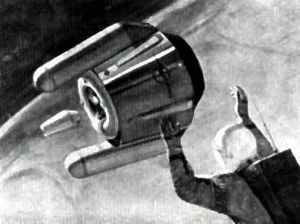 Deimos - MEM Docking Credit: NASA |
Status: Study 1964.
Separate Mars landers would bring crews to explore the Martian surface.
Phil Bono's second major objective was the manned exploration of Mars. Although an Apollo-type expendable spacecraft was considered, Bono felt a modified ROMBUS would be cheaper and safer although the less optimal single-stage design inevitably would translate to a 3.5 x higher launch mass in Earth orbit. The Mars-bound vehicle would weigh 3,965,758 kg in its 323-kilometer parking orbit. The trans-Mars injection (TMI) burn was planned for in May 1986. The four TMI propellant tanks (now empty) were jettisoned. After an interplanetary cruise period of 200 days, the ROMBUS spacecraft fired its engines to enter a 555-km parking orbit around Mars. The mother craft now had a mass of 984.75t after jettisoning two more empty fuel tanks. A conical 25-metric ton Mars Excursion Module (MEM) then departed with a landing crew of three astronauts.. The MEM's relatively cramped crew quarters and life support systems would only permit a relatively limited 20-day stay on the Martian surface. However, future missions would spend up to a year on Mars thanks to the unmanned cargo delivered by previous unmanned flights.
Mars Excursion Module Weight Summary
- Payload Returned To Mars Orbit 2,495 kg
- M.E.M. Ascent Stage (Dry) 1,361 kg
- Ascent Propellant (Isp=426s, dV=4572m/s) 7,620 kg
- M.E.M. Landing Stage (Dry) 6,758 kg
- Surface Payload 3,629 kg
- Landing Propellant (Isp=426s, dV=549m/s) 3,084 kg
- Total 24,947 kg
The crew would return to the waiting mother craft in an 11,475-kg Mars ascent vehicle that separated from the empty MEM landing module. Its RL-10 rocket engines consumed 7620kg of oxygen & hydrogen propellant during the 4572m/s ascent burn. Finally, 280 days after entering Mars orbit, the ROMBUS spacecraft fired its engines to return to Earth. The remaining two fuel tanks were then jettisoned after the final 3749m/s trans-Earth injection maneuver. The empty 340,194 kg vehicle landed on Earth 330 days later. The total round-trip travel time was 830 days. The "Deimos" mission would naturally have required some modifications to the basic ROMBUS design, including the addition of two SNAP-8 nuclear reactors for auxiliary power. The 6-crew would have lived inside a toroidal Command Center module which also housed 6300kg of food, oxygen & water (1.27kg/day/person).
Maneuver Summary:
- May 9, 1986 - From Earth Parking Orbit to Mars Escape: 3,965,737 kg gross mass in 323km Earth Orbit; 3,658 m/s dV
- May 9, 1986 - Vehicle After Mars Escape: 1,747,682 kg total mass
- November 25, 1986 - Vehicle Entered 555 km Mars Orbit: 984,744 kg total mass after maneuver; 2,347 m/s dV
- September 21, 1987 - Prepared for Trans-Earth Injection: 963,879 kg total mass; 3,749 m/s dV
- September 21, 1987 -Vehicle after Mars Escape: 415,035 kg total mass
- August 16, 1988 - Vehicle at Earth Entry (12,192 m/s aerobraking): 382,830 kg total mass; 119 m/s dV
- August 16, 1988 - Vehicle landed on Earth Surface: 340,193 kg total mass; 171 m/s dV
Project Deimos Mission Summary:
- Summary: Mars expedition designed to use reusable single-stage-to-orbit boosters, refueled in orbit, to take expedition to Mars
- Propulsion: LOX/LH2
- Braking at Mars: propulsive
- Mission Type: opposition
- Split or All-Up: all up
- ISRU: no ISRU
- Launch Year: 1986
- Crew: 6
- Mars Surface payload-metric tons: 4
- Outbound time-days: 200
- Mars Stay Time-days: 280
- Return Time-days: 350
- Total Mission Time-days: 830
- Total Payload Required in Low Earth Orbit-metric tons: 3965
- Mass per crew-metric tons: 660
- Launch Vehicle Payload to LEO-metric tons: 450
- Number of Launches Required to Assemble Payload in Low Earth Orbit: 8
- Launch Vehicle: ROMBUS
Family: Mars Expeditions. Country: USA. Launch Vehicles: Mars tactical rocket, Rombus. Agency: Douglas. Bibliography: 36, 514.
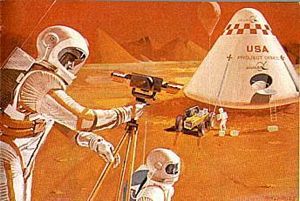 | Project Deimos Project Deimos Lunar Base |
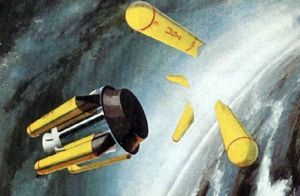 | Deimos Departure Credit: NASA |
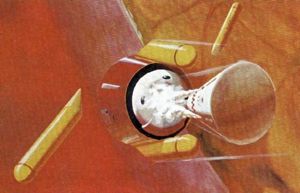 | Deimos - MEM Descent Credit: NASA |
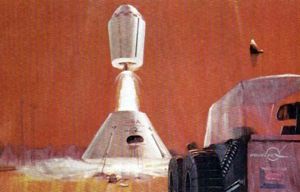 | Deimos - MEM Ascent Credit: NASA |
Back to top of page
Home - Search - Browse - Alphabetic Index: 0- 1- 2- 3- 4- 5- 6- 7- 8- 9
A- B- C- D- E- F- G- H- I- J- K- L- M- N- O- P- Q- R- S- T- U- V- W- X- Y- Z
© 1997-2019 Mark Wade - Contact
© / Conditions for Use